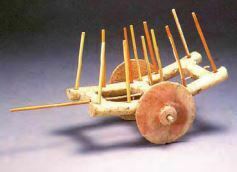Let’s recall
Question 1 How do archaeologists know that cloth was used in the Harappan civilisation?
Answer 1 Archaeologists found that actual pieces of cloth were found attached to the lid of a silver vase and some copper objects at Mohenjodaro. They have also found spindle whorls, made of terracotta and faience. These were used to spin thread. A stone statue of an important man found at Mohenjodaro shows him wearing an embroidered garment. This shows Harappan civilisation were using cloth.
Question 2 Match the columns
| Copper | Gujarat |
| Gold | Afghanistan |
| Tin | Rajasthan |
| Precious stones | Karnataka |
Answer 2
| Copper | Rajasthan |
| Gold | Karnataka |
| Tin | Afghanistan |
| Precious stones | Gujarat |
Question 3 Why were metals, writing, the wheel, and the plough important for the Harappans?
Answer 3
(1) Metals: They were used for making vessels and weapons. Harappan made copper tools. They also made ornaments of gold and silver.
(2) Writing: Writing was very important for the Harappans. There were scribes, people who knew how to write. Scribes helped prepare the seals and perhaps wrote on other materials that have not survived. It is important for communication.
(3) Wheel: The Harappans used the wheel in carts. They also used the wheel in spinning. The wheel was used by potters to make or shape pots and other things.
(4) Plough: Plough was used to prepare the land for farming by the Harappans.
Let’s discuss
Question 4 Make a list of all the terracotta toys shown in the lesson. Which do you think children would have enjoyed playing with the most?
Answer 4 Toy cart, Toy plough, Terracotta toys.

Question 5 Make a list of what the Harappans ate, and put a tick mark against the things you eat today.
Answer 5 Food items Harappans are wheat, rice, fruits, pulses, barley, peas, sesame, mustard, linseed.
The things we eat today are wheat, rice, fruits, pulses.
Question 6 Do you think that the life of farmers and herders who supplied food to the Harappan cities was different from that of the farmers and herders you read about in Chapter 2? Give reasons for your answer.
Answer 6
| Farmers and Herders of Harappan | Earlier Farmers and herders. |
| A new tool, the plough, was used to dig the earth for turning the soil and sowing seeds by the farmers of the Harappan times. | They were using mortar and pestle for grinding grains.They were made of bones. |
| As the Harappans’ region did not receive heavy rainfall, some form of irrigation might have been used. | They do not use any irrigation form. |
| They have well build granaries for storage. | They use clay pots and baskets for storage. |
| They lived in the outskirts of cities. | They have no settled cities. |
Let’s do
Question 7 Describe three important buildings in your city or village. Are they located in a special part of the settlement (e.g. the centre)? What are the activities that take place in these buildings?
Answer 7 In our city (or village) the following three important buildings are located:
(1) Community Hall or Gram Panchayat Bhawan or Municipal Committee Bhawan
(2) School Building
(3) Hospital
(4) Temple or Mosque or Church or Gurudwara
The following activities take place in these buildings respectively:
(1) Community Hall. Marriage Parties or Public Functions.
Gram Panchayat Bhawan. In this Bhawan (Building) Panchayat holds its meetings and discusses our village problems.
Municipal Committee Bhawan. In this Bhawan city’s elected members meet under a chairman and discuss problems of the city.
(2) School Building. In this building, education is provided to boys and girls of our village or city.
(3) Hospital. Here ill people or patients come and consult doctors, compounders or nurses as per their diseases or requirements.
(4) Temple or Mosque or Church or Gurudwara. People come and participate in prayer (or Namaz) according to their own religion and faith. (Any three points.)
Question 8 Are there any old buildings in your locality? Find out how old they are and who looks after them.
Answer 8 Yes, there are some old buildings in our locality. These buildings are looked after by a government department. The name of this department is the Archaeological Survey of India.

Leave a Reply